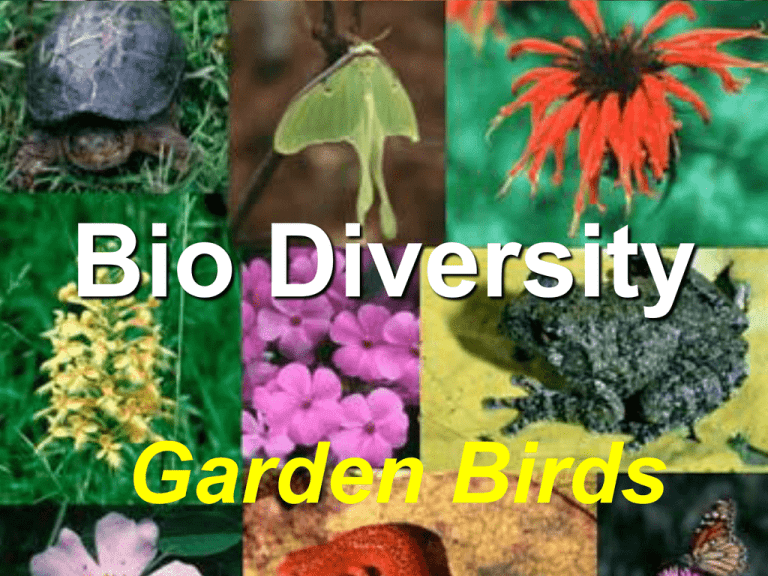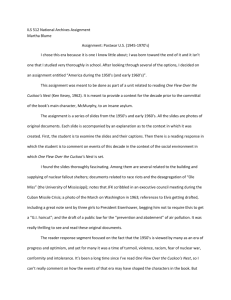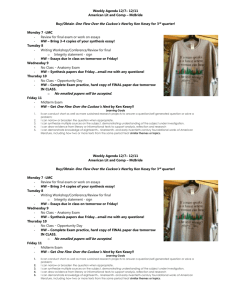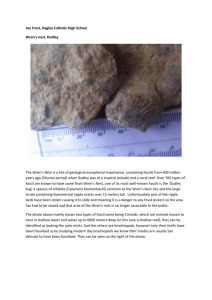Biodiversity Birds
advertisement

Bio Diversity Garden Birds Male has black feathers, yellow beak and orange eye ring. Female has brown feathers, Male is a great singer, first to sing in dawn chorus and last to go to bed. Makes a loud "Chak" at dusk or when cat is prowling. Makes cup shaped nest and lays 3-5 eggs that are blue green in colour. Robin Robins found in gardens all over Ireland - 5.5 million. Easily identified with red breast. Robins live for two years. They are very friendly and tame, they will feed from your hand in winter if they are hungry and cold. Robins are very possessive of their territory. The male will attack other males that come into the garden. Robins are in decline butt having one nest box in the garden will help to maintain the population. Wren The wren is the second smallest bird, Easily recognised with its tail held up. The wren has dark brown feathers and can be hard to see. More often seen than heard. Found in all habitats farm, mountain, garden, sea. The nest is made of moss in the shape of a sphere with an entrance at the side. Up to 50 wrens will nest together in winter to keep warm. A B Song Thrush has brown upper feathers with creamy under part and dark brown spots. Holds it head to one side as it moves along the ground in search of worms. Feeds on insects , berries, worms and snails. Will open the shells of snails by beating them against a brick, then pulls the snail out of the shell and wipes it on the ground. Blue Tit Has blue green, yellow feathers with dark markings on the head. Lives in woodland near oak trees. Will nest in the hole of a tree and will tear off the bark to get the insects underneath. Will nest in nest box if hole is the right size. People who put peanuts in feeders are helping blue tits to survive. Numbers have increased over past 5 - 10 years. Blue tits feed on greenfly and keep roses free of them. B u l l f i n c h The male Bullfinch has rosy pink face and breast, black cap and blue grey under parts. The colour is unlike that of any other bird. The female is like the male but the colours are duller. They are found in woodland, hedges and mature gardens. Will feed on seeds, berries and insects. Stubby beak adapted to feed on the flower buds of fruit trees. Can cause severe damage to crop of fruit by reducing yields. Used to be legally trapped in England for this reason but not anymore. Bullfinches tend to be shy and don't visit bird feeders. Cuckoo the sound of the cuckoo in late April tells us that summer is on the way. The male makes the sound of the familiar cuck-oo for 6 weeks after its arrival. The cuckoo does not build its own nest but just lays eggs that perfectly mimic those of other birds e.g robin, dunnock, meadow pipit. When the newly hatched cuckoo emerges from the egg it will take the eggs of the host bird on its back and drop them on the ground. The cuckoo spends the Winter in central and southern Africa and returns there in August. The population of cuckoo is in decline because the dunnock and meadow pipit are also in decline. This year we have been asked to record the first sound of the cuckoo in our locality and send it in to Spring Alive. Goldcrest Smallest bird, weighs as much as a 5c coin, just 5g. Yet female can lay up to 12 eggs in a clutch which is 1½ times its body weight. Hard to see as mainly scurries through tree trunks and branches, rarely keeping still. Song has a high pitched "tweedly, tweedly, tweedediddee". Nest is suspended near the end of a conifer branch, it is made from moss, lichen, spiders webs and lined with feathers, also nests among ivy. Eggs are white with brown specks. They only visit gardens in extreme cold winters and venture to bird tables for crumbs of cheese and bread. One of the top most 20 common birds;, dark brown upper and grey under parts. Active and noisy around farms, urban areas, parks and gardens. :Nests in a cavity in building or in a hole formed by missing brickwork. population has declined in recent years , will use nestbox and peanut feeder and take all kinds of scraps from bird table. Call is a lively !Chirrup" S p a r r o w Greylag Goose This is one of our winter visitors and it winters here during Oct - Mar having come from Iceland. It is the only breed of goose to winter here. Has grey brown feathers with orange yellow bill. Can be found nesting the lakeshore and marshy areas, Nests are found hear the sailing club. Population declined in 1990's in Iceland by 20% and a hunting ban was imposed in Iceland. Conservationists have started visiting nesting sites and carrying out a census on the number. New walkways around Blessington Lake will gave to avoid disturbing nests.











